Navigation
- Browse Navigation
- In short
- History
- All lenses and teleconverters Yongnuo
- Alternatives and cost comparisons
- Main Specifications
- Assembly
- Focusing
- Image quality
- Sample Photos on Nikon D90 (DX)
- Sample Photos on Nikon D700 (FX)
- Sample photos on Fujifilm S5 Pro (DX)
- Sample photos with processing
- Differences from DX 35 / 1.8G
- Differences from 35 / 2D
- My experience
- Video review
- Lens prices
- Results
- User Comments
- Add your review or question on the lens
It's important: Please note that the Yongnuo 35mm 1: 2 lens, in versions for Nikon and Canon cameras, looks very different from each other. Usually third-party lenses such as tokina, Tamron, Sigma, Carl Zeiss etc., have a very similar case design for versions for different systems. Yongnuo 35mm 1: 2 version for Nikon cameras replicates case design Nikon AF-S Nikkor 50mm 1: 1.8G SWM Asphericalversion Yongnuo 35mm 1: 2 for Canon EOS cameras copies the design of the case Canon Lens EF 50mm 1: 1.8 II.
In short
Yongnuo 35mm 1: 2 (YN35mm F2N) is a fast prime from the Chinese manufacturer Yongnuo Digital. The lens copied the body design of the original Nikon 50 / 1.8G and optical properties Canon lens EF 35mm 1: 2. All in all, good (all of a sudden for a Chinese lens!).
First of all, Yongnuo 35mm 1: 2 (YN35mm F2N) is interesting to owners motorless Nikon camerasAs replacement for popular lens Nikon DX AF-S Nikkor 35mm 1: 1.8G. Also Yongnuo 35mm 1: 2 can serve as a good substitute for old Nikon AF Nikkor 35mm 1: 2D.
The company has done work on the errors that I met with the model Yongnuo 50mm 1: 1.8, in the end, Yongnuo 35mm 1: 2 turned out to be better.
History
On April 21, 2015 a lens for Canon EOS cameras was presented - Yongnuo Lens EF 35mm 1: 2 (model YN35mm F2).
Almost a year and a half later, the Nikon version - Yongnuo 35mm 1: 2 (model YN35mm F2Nshown in this review), which was presented 1 September 2016 years.
Please note that there are two sub-versions of this lens that differ in depth of field - one has a depth of field scale for F / 16, the other does not (this sub-version is shown in this review).
Let me remind you that the first lens from Yongnuo Digital was a fifty dollars for Canon EOS cameras - Yongnuo Lens EF 50mm 1: 1.8 (YN50mm F1.8) submitted on December 27, 2014.
Alternatives and price comparisons
Below I have prepared a list with all similar lenses (fixes in the range of 30-40 mm) with automatic focus support for Nikon SLR cameras and indicated the difference in cost between them and the hero from this review:
- Yongnuo around in 4.5 times cheaper Nikon AF Nikkor 35mm 1: 2D (390 USD vs 85 USD for new lenses)
- approximately at 2 times cheaper Nikon AF Nikkor 35mm 1: 2 MKI (150 USD vs 80 USD per second lenses)
- approximately at 2.5 times cheaper Nikon DX AF-S Nikkor 35mm 1: 1.8G (200 USD vs 85 USD for new lenses)
- approximately at 6 times cheaper Nikon ED AF-S Nikkor 35mm 1: 1.8G (525 USD vs 85 USD for new lenses)
- approximately at 20 times cheaper Nikon N AF-S Nikkor 35mm 1: 1.4G (1700 USD vs 85 USD for new lenses)
- approximately at 3 times cheaper Nikon DX AF-S Micro Nikkor 40/ 2.8G (270 USD vs 85 USD for new lenses)
- approximately at 7 times cheaper Tamron 35mm F / 1.8 SP DI USD VC (600 USD vs 85 USD for new lenses)
- approximately at 10.5 times cheaper Sigma 35mm 1: 1.4 DG HSM | A (900 USD vs 85 USD for new lenses)
- approximately at 6 times cheaper Sigma 30mm 1: 1.4 DC HSM | A (500 USD vs 85 USD for new lenses)
- approximately at 14 times cheaper Sigma 40mm 1: 1.4 DG HSM | A (1200 USD vs 85 USD for new lenses)
- approximately at 2.5 times cheaper Sigma 30mm 1: 1.4 EX DC (200 USD vs 80 USD per second lenses)
- approximately at 2.5 times cheaper Sigma 30mm 1: 1.4 EX DC HSM (200 USD vs 80 USD per second lenses)
- approximately at 3 times cheaper Tokina MACRO 35 F2.8DX AT-X PRO (230 USD vs 80 USD per second lenses)
- approximately at 1.1 times cheaper yongnuo 40mm 1: 2.8 (90 USD vs 85 USD for new lenses)
As a result, the new Yongnuo 35mm 1: 2 (YN35mm F2N) is cheaper than even the cheapest option in the used state. I indicated prices based on average current value in online stores... Unfortunately, the used Yongnuo 35mm 1: 2 is sold only slightly cheaper than the new one, therefore for the 'used' version I have indicated a cost of $ 80.
In general, there is no cheaper AF lens mount for Nikon SLR cameras (both FX and DX) than the Yongnuo 35mm 1: 2, which would be shorter than 50 mm. In terms of cost, only the second-hand ones are approaching the new Yongnuo 35mm 1: 2. old men Nikon AF Nikkor 28mm 1: 2.8 (MKI) / Nikon AF Nikkor 28mm 1: 2.8 (MKII) / Nikon AF Nikkor 28mm 1: 2.8D (MKIII).
All Yongnuo Lenses
Bayonet mount Sony FE [DF, FULL FRAME] и Sony E[DA,APS-C]:
- yongnuo 11 mm 1:1.8 DA DSM WL S [announcement]
- yongnuo 16 mm 1:1.8 DA DSM S [announcement]
- yongnuo 35 mm 1: 2 DF DSM S [review]
- yongnuo 50 mm 1: 1.8 DF DSM S [announce]
- yongnuo 50 mm 1:1.8 DA DSM S [overview]
- yongnuo 85 mm 1: 1.8 DF DSM S [review]
- yongnuo 85 mm 1:1.8 DF DSM S II [announcement]
Bayonet mount Canon RF (mirrorless full frame):
- yongnuo 35 mm 1: 2 DF DSM R [review]
- yongnuo 35 mm 1:2 CR [announcement]
- yongnuo 50 mm 1:1.8 DF DSM R [to be announced]
- yongnuo 85 mm 1:1.8 DF DSM R (two subversions with different names) [review]
Bayonet mount Nikon Z [DF, FULL FRAME + DA,APS-C]::
- yongnuo 11 mm 1:1.8 DA DSM WL Z [announcement]
- yongnuo 35 mm 1:2 DF DSM Z [announcement]
- yongnuo 50 mm 1:1.8 DF DSM Z [announcement]
- yongnuo 50 mm 1:1.8 DA DSM Z [review]
- yongnuo 85 mm 1:1.8 DF DSM Z [announcement]
Bayonet mount fujifilm x [DA,APS-C]:
- yongnuo 11 mm 1:1.8 DA DSM WL X [announcement]
- yongnuo 50 mm 1:1.8 DA DSM X Pro [Announcement]
- yongnuo 50 mm 1:1.8 DA DSM X [announcement + overview]
For the system Micro 4 / 3:
- yongnuo 25 mm 1: 1.7 [review]
- yongnuo 42.5 mm 1: 1.7 [review]
- yongnuo 42.5 mm 1:1.7 II [overview]
- yongnuo 12-35 mm 1:2.8-4 STM ASPH MACRO [announcement]
Bayonet mount Nikon f (mirrored full frame):
- yongnuo 14 mm 1: 2.8 [overview]
- yongnuo 35 mm 1: 2 [overview]
- yongnuo 40 mm 1: 2.8 [overview]
- yongnuo 50 mm 1: 1.8 [review]
- yongnuo 50 mm 1: 1.4 E [overview]
- yongnuo 60 mm 1:2 MACRO MF [overview]
- yongnuo 85 mm 1: 1.8 [overview]
- yongnuo 100 mm 1: 2 [overview]
Bayonet mount Canon EF (mirrored full frame):
- yongnuo 14 mm 1:2.8 [review N]
- yongnuo 35 mm 1: 2 [review]
- yongnuo 35 mm 1: 1.4 [overview]
- yongnuo 35 mm 1: 1.4C DF UWM [announce]
- yongnuo 50 mm 1: 1.8 [overview]
- yongnuo 50 mm 1:1.8 II [overview]
- yongnuo 50 mm 1: 1.4 [overview]
- yongnuo 60 mm 1:2 MACRO MF [review N]
- yongnuo 85 mm 1: 1.8 [review]
- yongnuo 100 mm 1: 2 [overview]
Cameras:
- Yongnuo YN433 (2023, Micro 4/3, 20 MP, 4K)
- Yongnuo YN455 (2021, Micro 4/3, 20 MP, 4K)
- Yongnuo YN450/450M (2019, Micro 4/3 -> Canon EF, 16 MP, 4K)
Lenses and cameras and many other products from Yongnuo can easily be found at Authorized Yongnuo Dealer / Store on Aliexpres.
My video on all Yongnuo lenses here.
Main technical characteristics of YONGNUO 35mm 1: 2 (YN35mm F2N):
| Review Instance Name | Near the front lens: YONGNUO Ø58mm YN35mm F2N. On the case: 35mm 1: 2 2K011601. On the box: YONGNUO DIGITAL wide-agnle prime lens YN35mm F2N |
| Basic properties |
|
| Front Filter Diameter | 58 mm, plastic thread for filters |
| Focal length | 35 mm, EGF for Nikon DX cameras is 52.5 mm |
| Zoom ratio | 1 X (this is a fixed lens, it does not have a zoom) |
| Designed by | for full and cropped Nikon digital cameras |
| Number of aperture blades | 7 rounded petals form a rather round hole at F / 2-F / 3.5 and a hole in the shape of an irregular heptagon at F / 3.5-F / 19. |
| Tags | focusing distance in meters and feet, bayonet mount mark, hood mount mark. There is no GRIP scale (only decorative white stripes in its place). There is a subversion of this lens with the depth of field scale for F / 16 (view). |
| Diaphragm | from F / 2 to F / 19, without aperture ring, lens analog Nikon G. Please note that F / 19 can only be set when a step is used. exposure 1/2 steps. If the step is 1/3 of the step, then the minimum aperture value is F / 18. |
| MDF (minimum focusing distance) | 0.25 m, maximum magnification ratio for macro photography is 1: 4.3 |
| The weight | 180 g |
| Optical design | 7 elements in 5 groups. The lens does not use special optical elements in its optical design. All elements are made of optical glass.
The optical design is identical to the lens. Yongnuo Lens EF 35mm 1: 2. Please note that I didn’t find the circuit diagram for the YN35mm F2N (for Nikon), because here I have shown the lens arrangement for YN35mm F2 (for Canon). A similar optical circuit uses a lens Canon lens EF 35mm 1: 2. |
| Lens hood | Plastic, bayonet type. The model is unknown and not indicated in the instructions. It can be supplied. |
| Manufacturer country | The country of manufacture is not indicated on the lens case. But, in fact, the lens is made in China. |
| Period | From 1 September to 2016 |
| Instructions | View my scan (English only) |
| Video review | Here |
| Price |
It turns out funny situation: Yongnuo Lens EF 35mm 1: 2 Yongnuo Lens Made In China (YN35mm F2, for Canon EOS) copied / upgraded optical circuit Canon lens EF 35mm 1: 2after which the same circuit began to be used in YONGNUO 35mm 1: 2 (YN35mm F2N, for Nikon). Lens Yongnuo 50mm 1: 1.8 (YN50mm F1.8N, for Nikon) copied the case design from the original Nikon AF-S Nikkor 50mm 1: 1.8G SWM Aspherical, after which the same design was used in the YONGNUO 35mm 1: 2 (YN35mm F2N, for Nikon). As a result, the lens from this review is a mixture of Nikon 50 / 1.8G и Canon 35 / 2.
Assembly
The lens came to the review completely new.
In a small box is a warranty card, instructions in Chinese and English, and the lens itself with a front (YN-58) and a back cover. The box is made in the colors typical of the golden boxes of Nikon Nikkor lenses.
The lens is assembled well. Yongnuo 35mm 1: 2 has a metal bayonet mount. The focusing ring is rubberized. The contacts of the microcircuits are stated to be gold-plated to improve current flow.
Of the drawbacks of the assembly, I want to highlight only the fact that not all Yongnuo 35mm 1: 2 lenses come with a hood and a carrying case. Also, I did not like the fact that the serial number of the lens is very quickly erased from the lens barrel.
Important: some users note that the Yongnuo 35mm 1: 2 with the original Nikon HB-47 hood (for the lens Nikon 50 / 1.8G) can give strong vignetting.
UPDATE 1: With some cameras, the memory card access lamp blinks when off. Most likely the camera is constantly 'disconnecting / connecting' the lens. The exact reason is unknown.
UPDATE 2: With some cameras, the battery power decreases when turned off.
It is also very important that the Yongnuo 35mm 1: 2 is devoid of the mechanical defects that were inherent in the model Yongnuo 50mm 1: 1.8.
Focusing
The lens has built-in focus motortherefore Yongnuo 35mm 1: 2 will automatically focus on all Nikon DSLR cameras, even on amateur.
The lens will automatically focus on all Nikon DSLR cameraseven on amateur series models Nikon DXthat do not have a built-in focus motor: D40, D40x, D60, D3000, D3100, D3200, D3300, D3400, D3500, D5000, D5100, D5200, D5300, D5500, D5600as well as mirrorless cameras Nikon Z with adapter FTZ / FTZ II.
To be extremely precise, the Yongnuo 35mm 1: 2 is an analog of the Nikon series lenses AF-I. Unlike Nikon AF-S lenses that use ultrasonic focus motors Nikon SWMold lenses Nikon AF-I use the built-in buzzing micro focus motor.
When focusing, the motor is noisy. The noise is small. It is very good that the Yongnuo 35mm 1: 2 noise is less than motorless Nikon AF Nikkor 35mm 1: 2D. At the same time, the Yongnuo 35mm 1: 2 noise is not much stronger than compact ultrasonic motor у Nikon DX AF-S Nikkor 35mm 1: 1.8G.
Auto focus on the lens average. Focusing time from infinity to MDF and vice versa is significantly longer than that of Nikon AF Nikkor 35mm 1: 2D and about the same as Nikon DX AF-S Nikkor 35mm 1: 1.8G. I want to note that focus confidence with original lenses, significantly higher than with Yongnuo 35mm 1: 2.
When used on cameras Nikon D90 и Fujifilm FinePix S5 Pro (with unpretentious Multi-CAM 1000 focusing system) and Nikon D700 (with advanced focusing system Multi-CAM 3500FX) the lens behaves well, rarely makes a mistake in focusing. With precision and clinging focus, I had no particular problems. On camera Nikon D90 I checked the presence of the back and focus front at different focusing distances (infinity and MDF as well). Pictures taken using the Live View mode (which does not suffer from back / front focus) were used as a measure. Focusing accuracy using phase sensors completely coincided with the Live View mode.
When focusing, the front lens group moves in the middle of the frame of the housing. I can’t say that the lens has internal focus. But when focusing the lens does not change its size, and the filter is wound on a fixed outer part of the frame of the housing. This type of focusing can also be found in Nikon 50 / 1.8G и Nikon 50 / 1.4G.
The focus ring is rubberized and in manual focus mode rotates approximately 110-120 degrees. When extreme positions are reached, the ring abuts. The focus distance scale rotates in the opposite direction of the focus ring rotation. Manual focus is quite convenient. During manual focusing, one can hear 'plastic rubbing against plastic', while the ring rotates smoothly and is quite pleasant. Direction of rotation of the focus ring opposite to the original Nikon Nikko lensesr.
There is a 'AF-MF' (auto focus / manual focus) mode switch on the lens body. Switch positions are swapped compared to the original Nikon DX 35 / 1.8G ('AF-MF' <-> 'M-M / A'). During autofocus, the focus ring remains stationary and can be freely rotated 360 degrees without affecting focus.
The lens has a window with a focus distance scale in meters and feet. The minimum focusing distance is 25 cm, and the maximum magnification ratio is 1: 4.3 (a good indicator for such a lens).
Other features:
- Yongnuo 35mm 1: 2 has no focus problems in Live View (tested on Nikon D90 и Nikon D700), but it focuses very slowly and uncertainly.
- The lens transmits the focus distance to the subject in the camera (analog Nikon D, Nikon G).
- Important: Yongnuo 35mm 1: 2 incorrectly indicates the focus distance to the subject. The camera always receives only distance values equal to 38 cm or 45 cm. At the same time, I had no problems with measuring exposure with all the cameras on which the lens was tested, and there were no problems while working with the flash (I used the flash while shooting baptismflash SB-900 worked aperture-priority auto).
- Yongnuo 35mm 1: 2 has a slightly pronounced 'Focus Breathing' effect (changes in viewing angle during focusing). During focusing towards the MDF, the viewing angle decreases.
- Focusing is performed by simultaneously moving the entire lens block (all lenses) relative to the focal plane.
- Yongnuo 35mm 1: 2 does not have a hard stop (hard infinity mechanical stop) which allows you to accurately and quickly focus the lens to infinity under any external temperature conditions. For accurate aiming at infinity, you cannot just bring the focus ring to its extreme position.
- Focus shift (shift-focus) is missing.
- Important: Yongnuo 35mm 1: 2 is a third-party lens. It may happen that it will not work correctly with the new Nikon cameras, which will be presented after the announcement of this lens. Details on this issue are considered by me. here. Also, the lens may strangely lead with some other cameras (example).
- Important: in focus mode AF-C (continuous tracking mode) The Yongnuo 35mm 1: 2 lens sometimes did not bring the focus and focused at a considerable distance to the subject. This is not a front focus, but some specifics of the lens. I noticed this feature on all three cameras that tested the Yongnuo 35mm 1: 2. Pressing the focus activation button again causes the lens to focus accurately and continue to monitor the subject.
- Unknown compatibility with teleconverters.
- Unknown compatibility with FT-1 adapter for system cameras Nikon 1.
If you discard minor flaws, then the lens is focused with focus, and the well-thought-out housing design and the 'AF / MF' switch make the Yongnuo 35mm 1: 2 more convenient to handle than Nikon AF Nikkor 35mm 1: 2D.
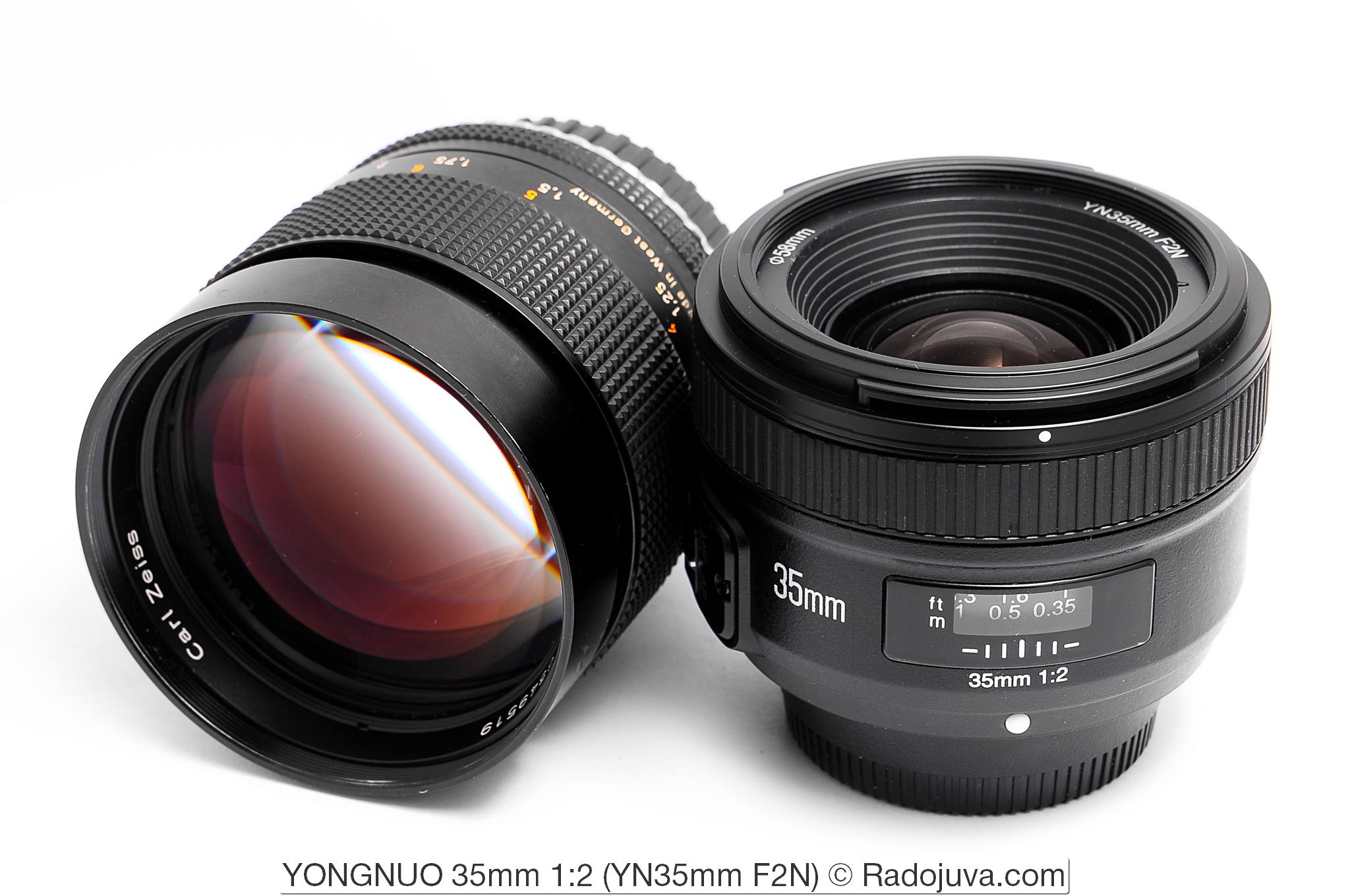
Noble Carl Zeiss Planar 1,4 / 85 T * (Lens made in West Germany, C / Y) and unpretentious YONGNUO 35mm f / 2 (YN35mm F2N)
Image quality
Image quality is at a decent level. Not to paint for a long time: YONGNUO 35mm f / 2 is optically no worse than the original Nikon AF Nikkor 35mm 1: 2D.
YONGNUO 35mm f / 2 inferior Nikon DX AF-S Nikkor 35mm 1: 1.8G by resolution, but wins by chromatic aberration.
Optical advantages and disadvantages are described in the results.
Below is a GIF animation of optical circuits Canon lens EF 35mm 1: 2 и Yongnuo Lens EF 35mm 1: 2 Yongnuo Lens Made In China. The same optical scheme is used for the lens from this review.

GIF animation demonstrating optical schemes of lenses Canon lens EF 35mm 1: 2 и Yongnuo Lens EF 35mm 1: 2 Yongnuo Lens Made In China (the same scheme is used for the lens from this review)
Sample photos on Nikon D90
Photos in the gallery below are shown. without treatment... Some of the photos are converted from the original RAW files using the original Nikon ViewNX-i utility without additional adjustments, the other part is the original on-camera JPEG.
Download source files in format JPEG can at this link (114 files in the '.JPG' format, 735 MB). Small photo report on Nikon D90 and Yongnuo 35mm f / 2 (YN35mm F2N) can be seen here.
Sample Photos on the D700
Photos in the gallery below are shown. without treatment Conversion of source RAW files with the original Nikon ViewNX-i utility without additional adjustments.
You can download source files in RAW format (14-bit, lossless compression) at this link (48 files in the '.NEF' format, 681 MB).
Sample photos on Fujifilm FinePix S5 Pro
Photos in the gallery below are shown. without treatment, source on-camera JPEG. Part of the photo was obtained using a polarizing filter Hoya 58mm PL-CIR.
Download source files in format JPEG can at this link (114 files in the '.JPG' format, 611 MB).
Sample photos from a small processing can look in my gallery at 500px.
The main differencesI'm between Nikon DX 35 / 1.8G and Yongnuo 35mm 1: 2
- Nikon DX 35 / 1.8G is a class lens Nikon DX (for cropped cameras), Yongnuo 35/2 is a class lens FX (for full-format cameras).
- Nikon DX 35 / 1.8G 1/4 foot lighter than Yongnuo 35/2. During real photography, the difference in aperture is not felt.
- Yongnuo 35/2 is a newer lens introduced 7 years after the release Nikon DX 35 / 1.8G.
- Nikon DX 35 / 1.8G 20 grams heavier than Yongnuo 35/2. Yongnuo 35/2 does not always come with an integrated hood.
- У Nikon DX 35 / 1.8G Yes rubber lens mount sealwhich makes the mount mounts dustproof and waterproof.
- Lenses use different focus motors. Yongnuo 35/2 uses a conventional micro motor, Nikon DX 35 / 1.8G uses a Nikon SWM ultrasonic motor.
- Nikon DX 35 / 1.8G has the ability to constantly manually control the focusM / A'. For manual focus, the Yongnuo 35/2 must be set to 'MF'.
- Different optical schemes. Nikon DX 35 / 1.8G uses a modern optical scheme, including one aspherical element, which allows to achieve better image, especially on open diaphragms.
- Nikon DX 35 / 1.8G worse for macro photography due to a more meager maximum magnification factor (1: 6.3 vs 1: 4.3).
- Yongnuo 35/2 has a window with a focus distance scale in meters and feet.
- Yongnuo 35/2 uses 58 mm diameter filters, Nikon DX 35 / 1.8G - 52 mm in diameter.
- Modern Nikon cameras can automatically correct some distortion of the Nikon 35 / 1.8G lens. With Yongnuo 35/2, some image enhancement functions will not be available, since this lens is not in the memory of modern cameras.
- New Nikon DX 35 / 1.8G It costs significantly more than the new Yongnuo 35/2.
The main differences between Nikon 35 / 2D and Yongnuo 35mm 1: 2
- Yongnuo 35/2 is a newer lens introduced 21 years after the release Nikon 35 / 2D.
- Nikon 35 / 2D about 20 grams heavier than Yongnuo 35/2.
- Lenses use different optical systems.
- For focusing, the Yongnuo 35/2 uses a built-in micro focus motor. Nikon 35 / 2D has inboard motor focusing and focusing due to the focusing motor built into the camera. This is one of the main functional differences between the lenses.
- Unlike Nikon 35 / 2D, during focusing, the Yongnuo 35/2 does not have an extension of the body rim (the trunk does not move out).
- Nikon 35 / 2D It has an aperture control ring, which Yongnuo 35/2 does not have.
- Yongnuo 35/2 does not have the depth of field scale and the infrared shift marks that the Nikon 35 / 2D.
- Yongnuo 35/2 uses 58 mm diameter filters, Nikon 35 / 2D - 52 mm in diameter.
- Optically, the lenses are close to each other.
- Modern Nikon cameras can automatically correct some lens distortion Nikon 35 / 2D. With Yongnuo 35/2, some image enhancement functions will not be available, since this lens is not in the memory of modern cameras.
- New Nikon 35 / 2D It costs a lot more than the new Yongnuo 35/2.
My experience
Many users asked me to prepare a Yongnuo 35mm 1: 2 review, so I bought a lens specifically for this purpose.
I think Yongnuo 35mm 1: 2 is an adequate alternative to the popular Nikon DX 35 / 1.8G and for old Nikon 35 / 2D... The only thing that confuses me about Yongnuo 35mm 1: 2 is the unknown about the quality spread between the models, as evidenced by completely different information on the network. If all the models sold are optically and mechanically close to the version from my review, then the Yongnuo 35mm 1: 2 should soon become a legendary / folk lens.
I liked Yongnuo 35mm 1: 2 so much that I I recommend it for purchase and use. Yongnuo 35mm 1: 2 has an excellent price / quality ratio.
I used this lens very actively for a month with different cameras, shot about 5.000 frames on it, while it withstood all the loads.
If there is a choice between Yongnuo 50mm 1: 1.8 and Yongnuo 35mm 1: 2, then I recommend the latter. The reasons for this recommendation: 35 mm on the crop can serve as a good staffer, with it it is much more convenient to carry out a diverse survey, it is devoid of some mechanical flaws that I met with the model Yongnuo 50mm 1: 1.8.
I am often asked about cheap wide-angle or standard / universal fix for crop, often the question concerns Soviet lenses of the brand WORLD. Now I will recommend saving up some money and decide on China-plastic-fiction.
For some users, I would even recommend replacing any standard whale lens class 18-55/3.5-5.6 to Yongnuo 35/2. The 35mm focal length is in the middle of the 18-55mm range, (18+55)/2=36.5. EGF The lens on Nikon DX cameras is 52.5 mm (fifty dollars), which is the classic standard focal length. Thus, Yongnuo 35mm 1: 2 can be an everyday prime lens for Nikon DX cameras (i.e. for crop).
Video review
A short video review is possible watch on my Youtube channeleither here:
Prices
Prices for the YONGNUO 35mm f / 2 (YN35mm F2N) lens at aliexpress.com can see and buy at this link.
On the aliexpress.com This lens is sold at the cheapest prices. In all other places, for example, in local stores of the countries of the former CIS, Yongnuo 35mm 1: 2 costs a little more.
Results
Yongnuo 35mm 1: 2 turned worthy copy... The price / quality ratio is high (this link is only $ 100). Of course, there are small flaws, but in general it is very attractive lens for amateur and novice enthusiasts.
Advantages
- very low cost (about 100 dollars)
- built-in focus motor, compatible with the younger line of Nikon DX cameras
- virtually internal focusing, no rotation of the focus ring during auto focus
- smooth rotation of the focus ring, convenient enough manual focus
- presence of a window with a focus distance scale
- good build quality: metal bayonet mount, rubberized focus ring, light weight, bayonet hood
- small MDF, good magnification factor for macro photography
- rounded seven-blade diaphragm
- no focus shift
- confident sharpness at F / 2.0 in the center of the frame
- good contrast, neutral color reproduction
- fairly round blur discs on F / 2-F / 2.8 apertures
- moderate distortion
- moderate chromatic aberration in the center of the frame
- low vignetting on Nikon DX cameras (crop)
- good lateral light resistance
Disadvantages
- low focus speed
- not always sure focus
- slight noise from the focus motor
- incorrect indication of the focusing distance (the lens always reports to the camera only one of the two 'hardcoded' values about the distance to the subject)
- the survivability of this lens and the spread in quality are unknown
- lack of a hood in the delivery set (maybe not all sets are delivered without a hood)
- lack of constant manual focus control
- focus ring and distance scale have different directions of rotation (psychological discomfort)
- the direction of rotation of the focus ring is opposite to the original Nikon Nikkor lenses
- direction of 'AF / MF' switch opposite to original Nikon Nikkor lenses
- small effect of 'Focus Breathing' (changes in viewing angle during focusing)
- the lack of the depth of field and strange strips-trompe l'oeil that imitate it
- there may be incompatibility with some cameras and / or teleconverters (no exact data)
- low battery with some cameras turned off (e.g. D3000)
- blinking of the memory card access lamp with some cameras in the off state
- lack of data about the lens in modern cameras, which makes it difficult to automatically correct some types of distortion (distortionvignetting etc.)
- not enough round blur discs on F / 3.5-F / 19 apertures
- tangible vignetting on full-frame cameras and open apertures
- drop in sharpness at the edges and corners of the frame on full-frame cameras
- Poor backlighting due to specific glare (see examples)
Please ask all questions regarding the lens in the comments, I will definitely try to answer. Comments do not require any registration or any personal data.
UPDATED: review appeared Yongnuo 40mm 1: 2.8 (model YN40mm F2.8N).
Comments on this post do not require registration. Anyone can leave a comment. Many different photographic equipment can be found on AliExpress.
Material prepared Arkady Shapoval. Training/Consultations | Youtube | Facebook | Instagram | Twitter | Telegram

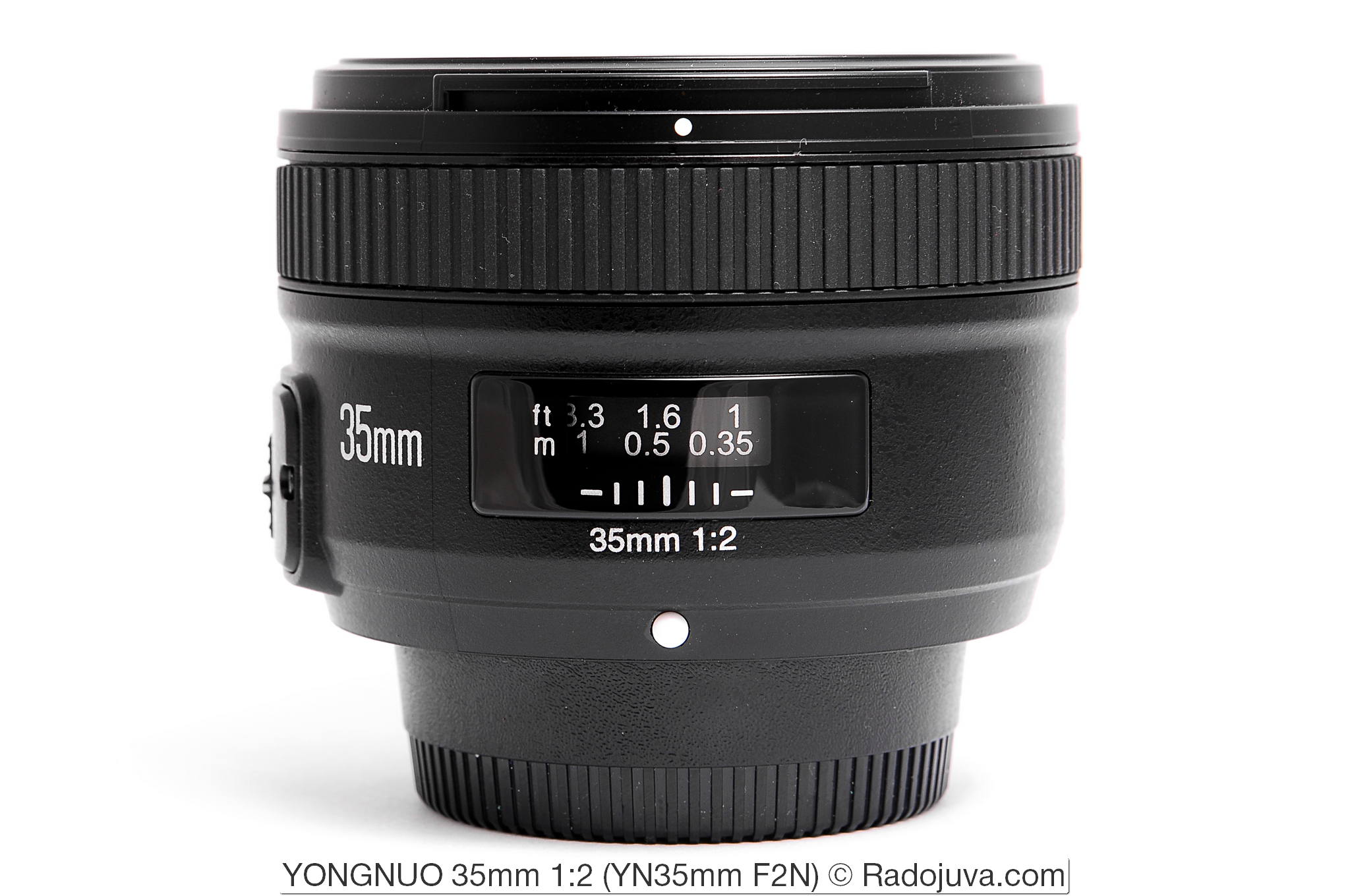

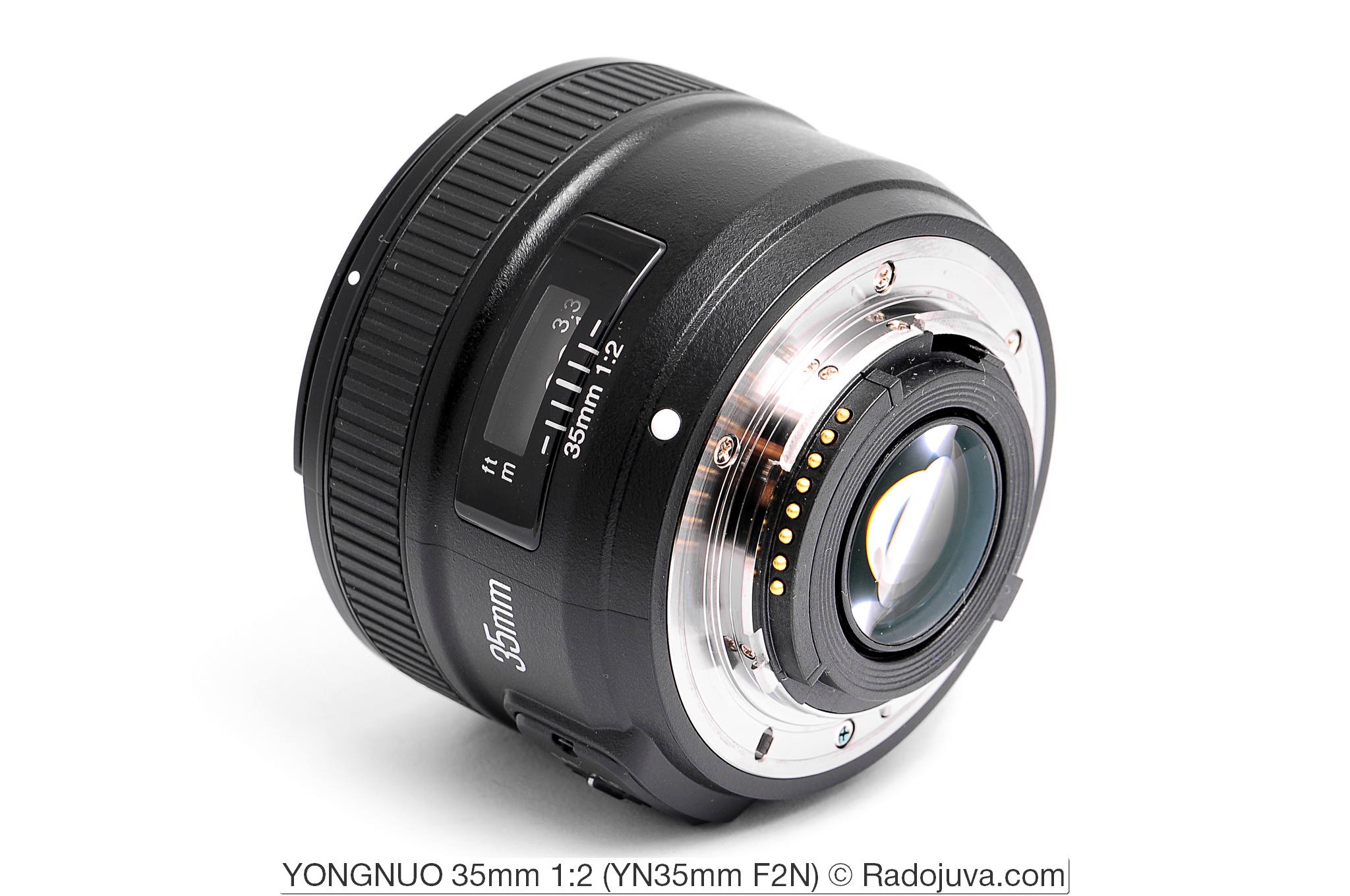
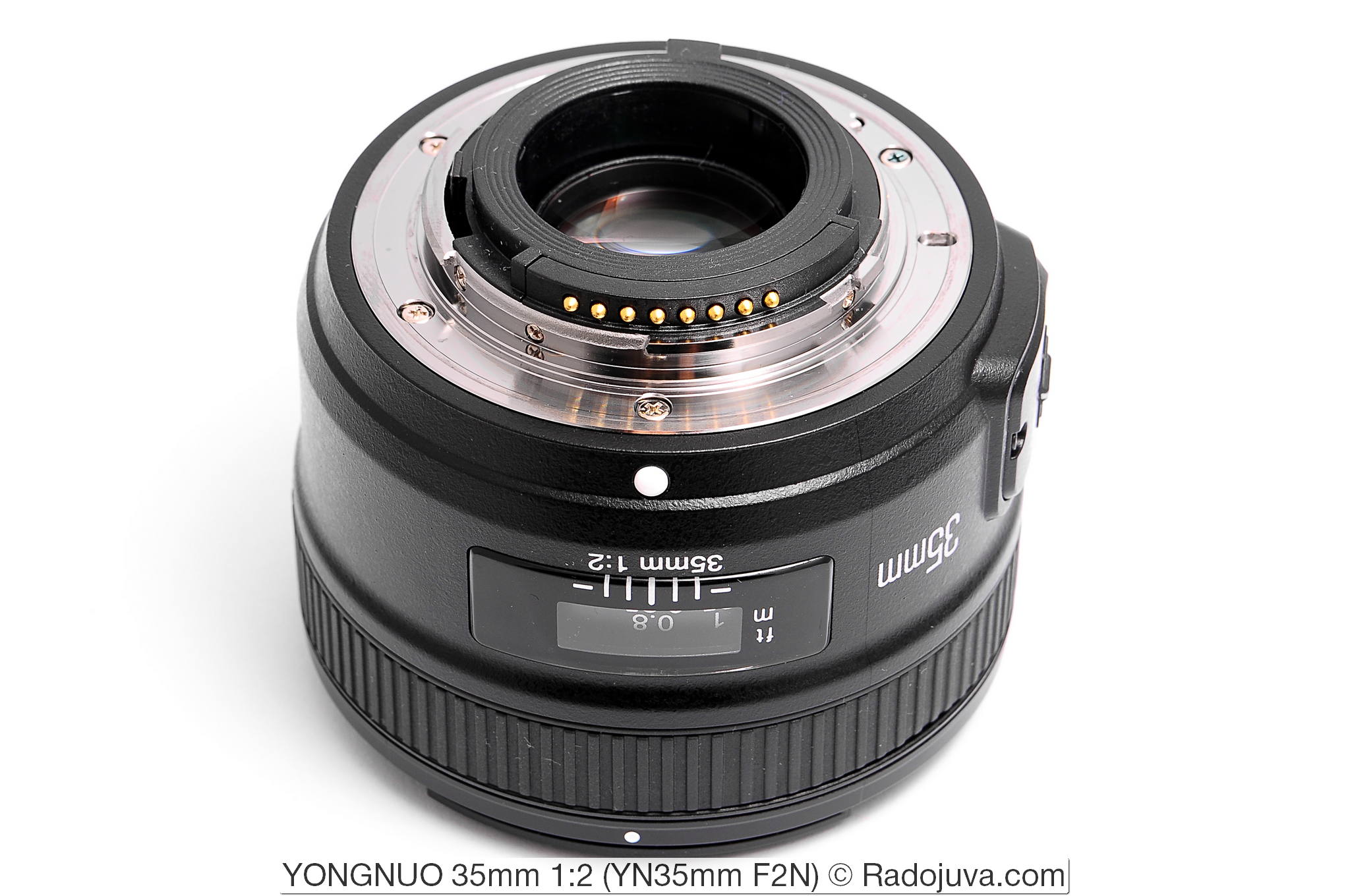
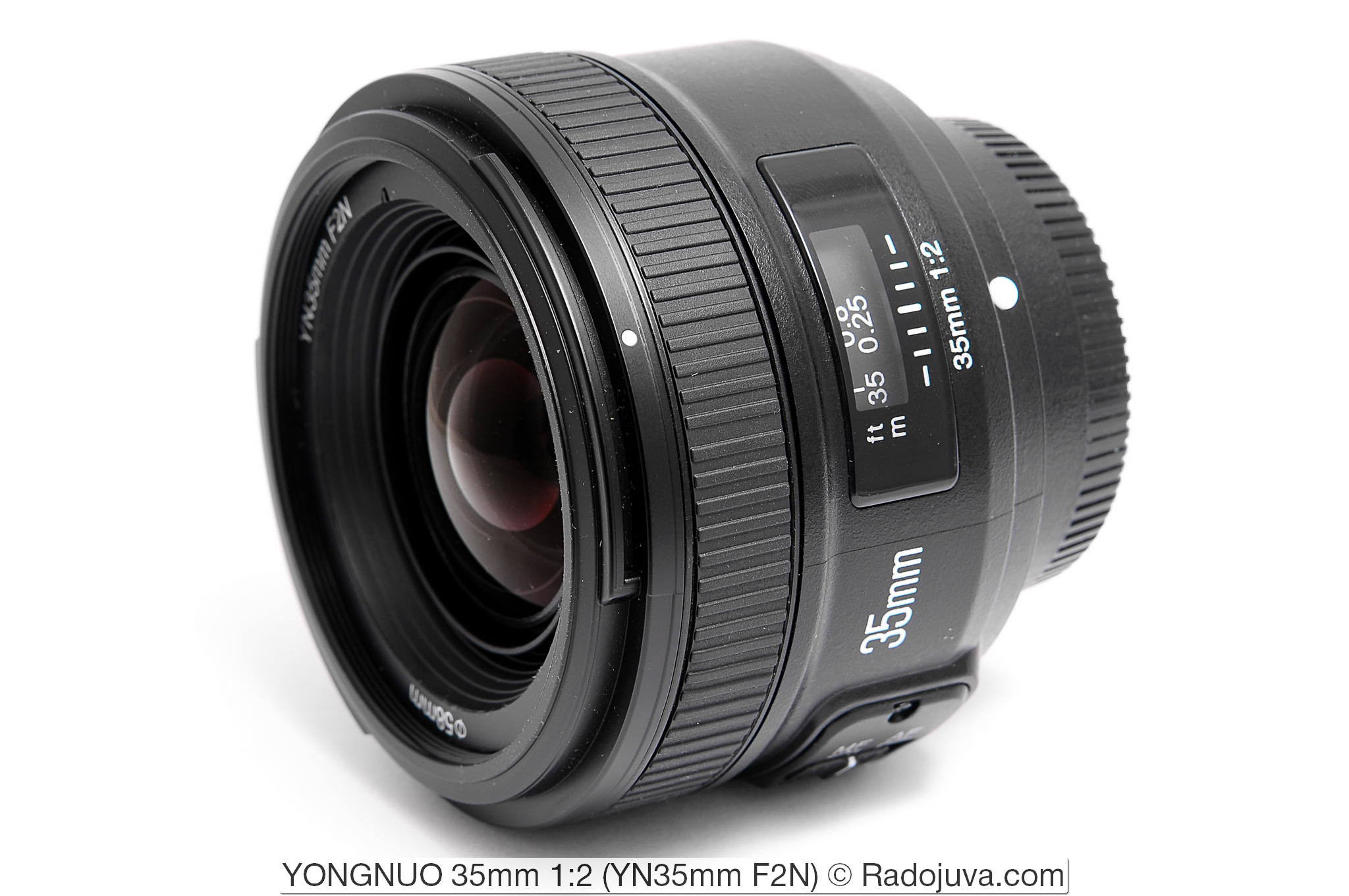
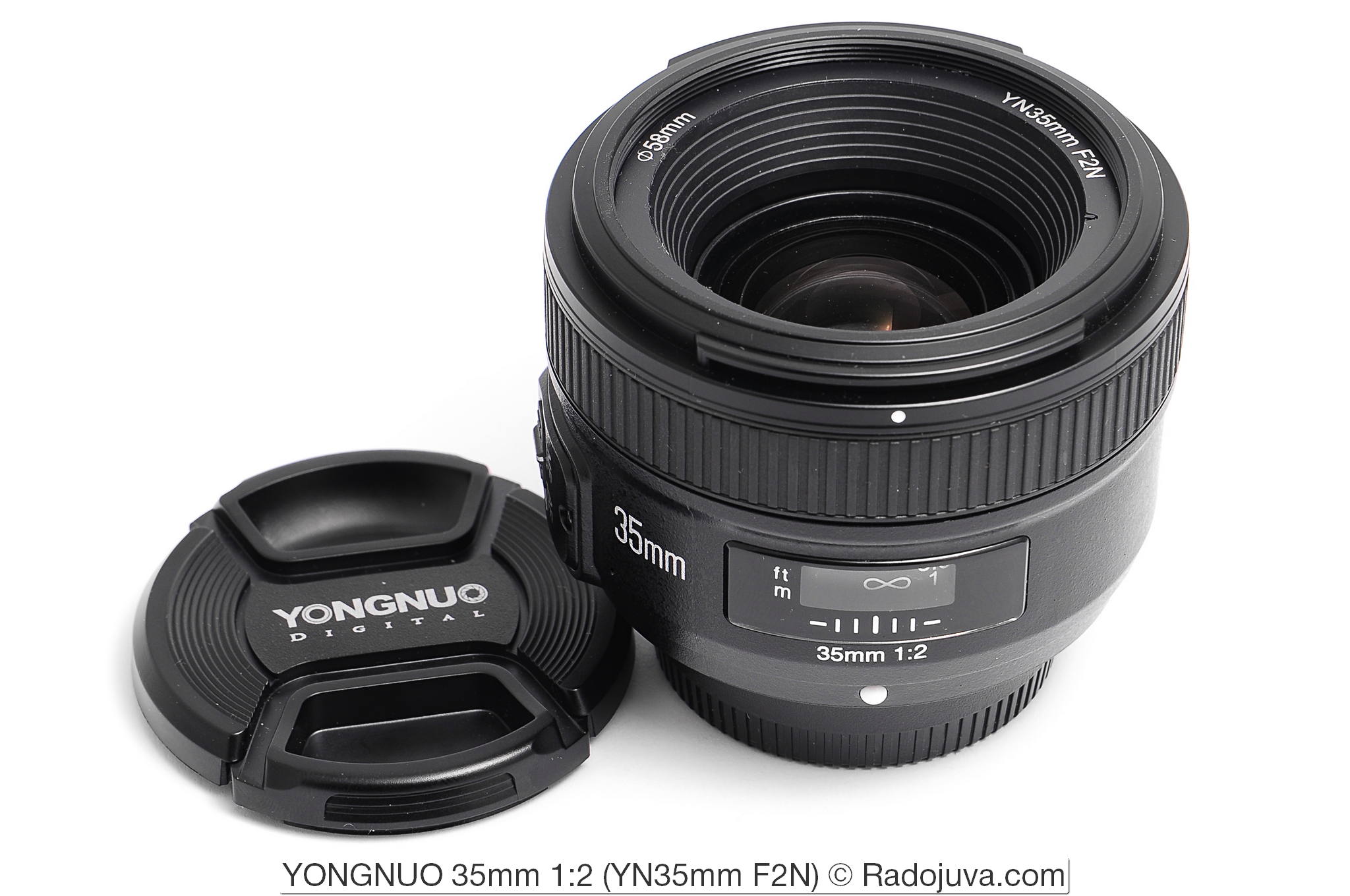
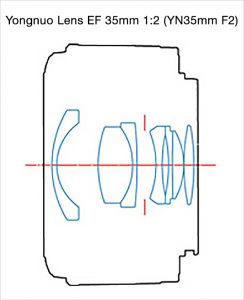
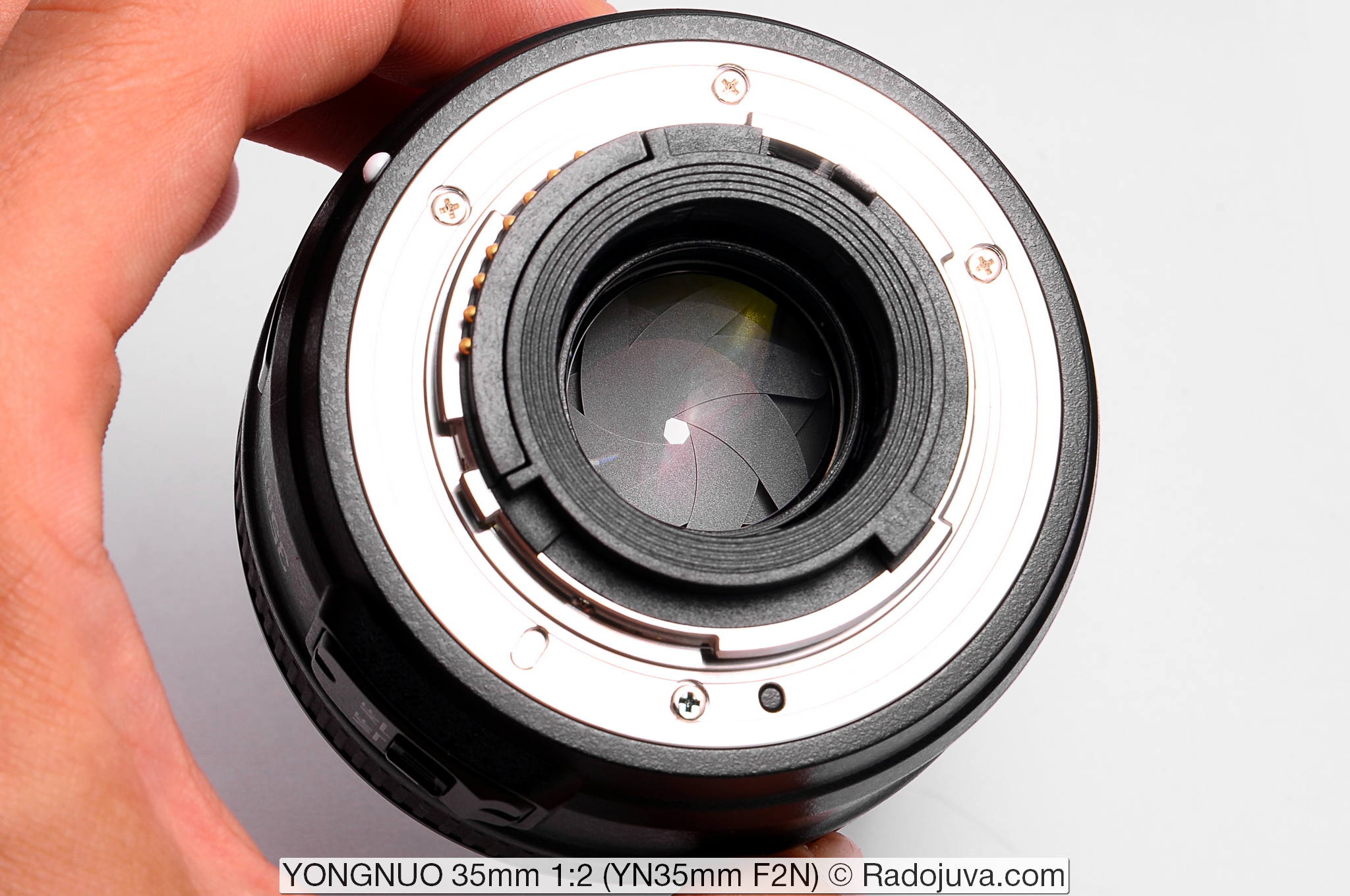
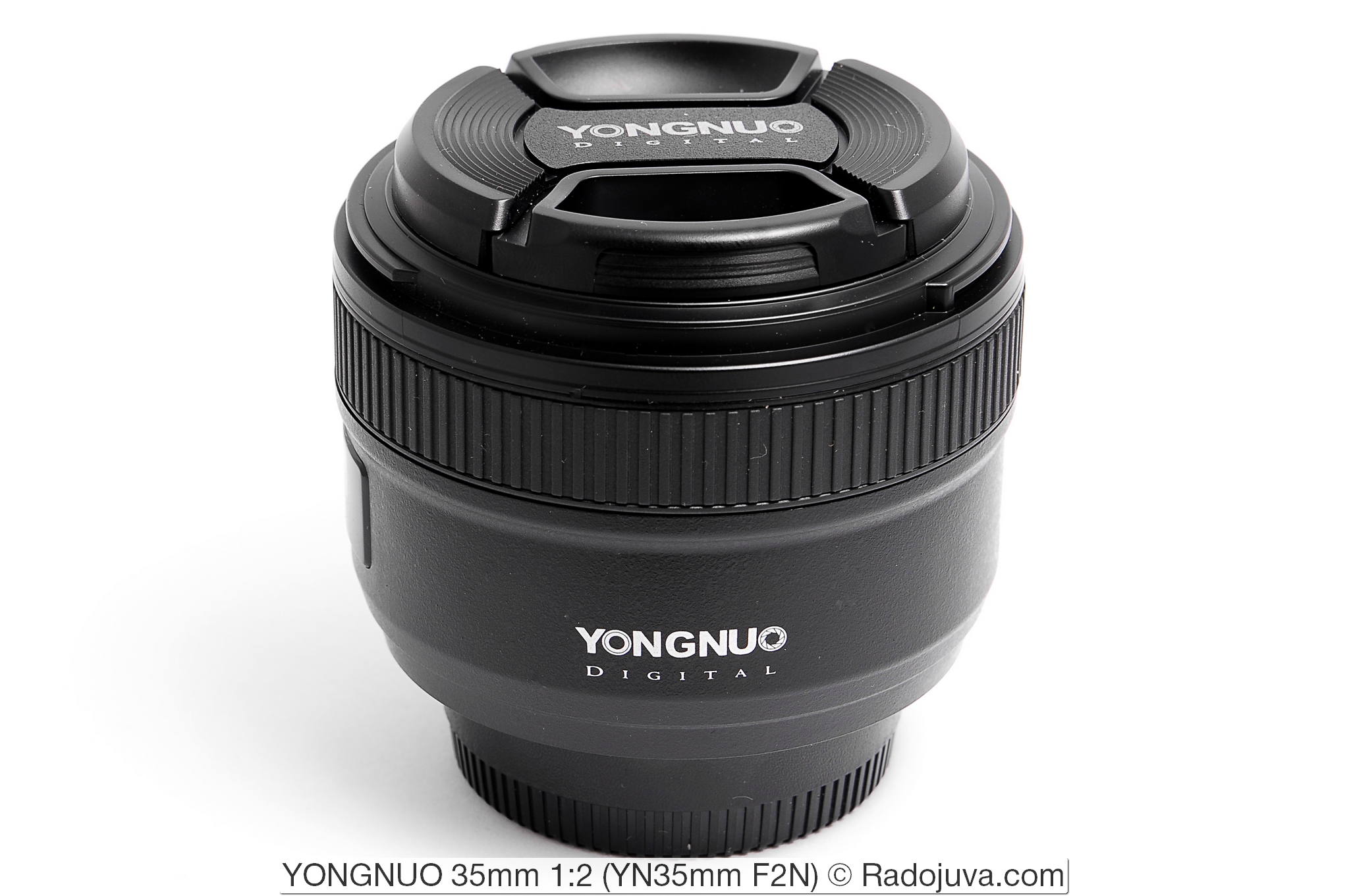




































































































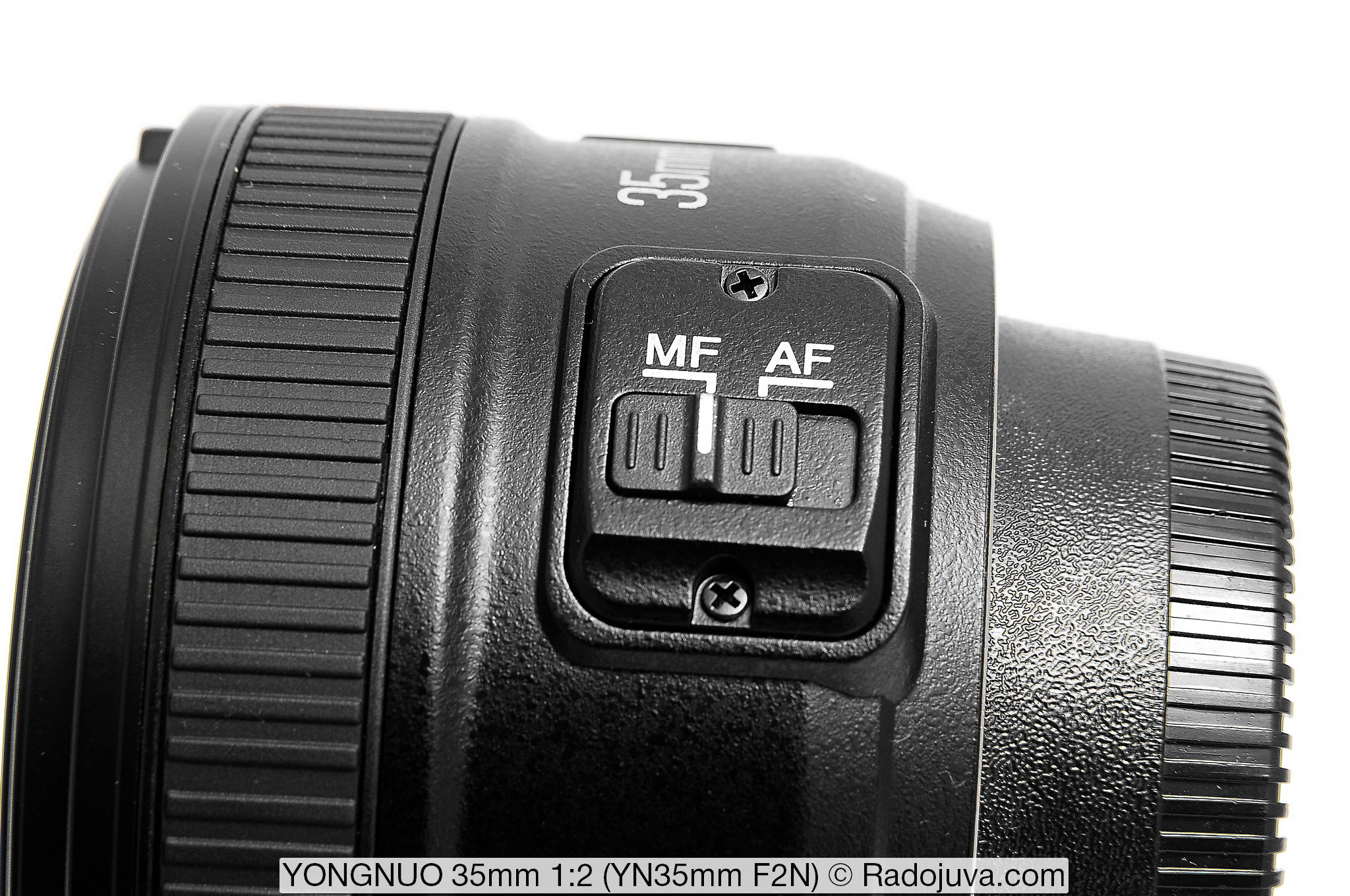
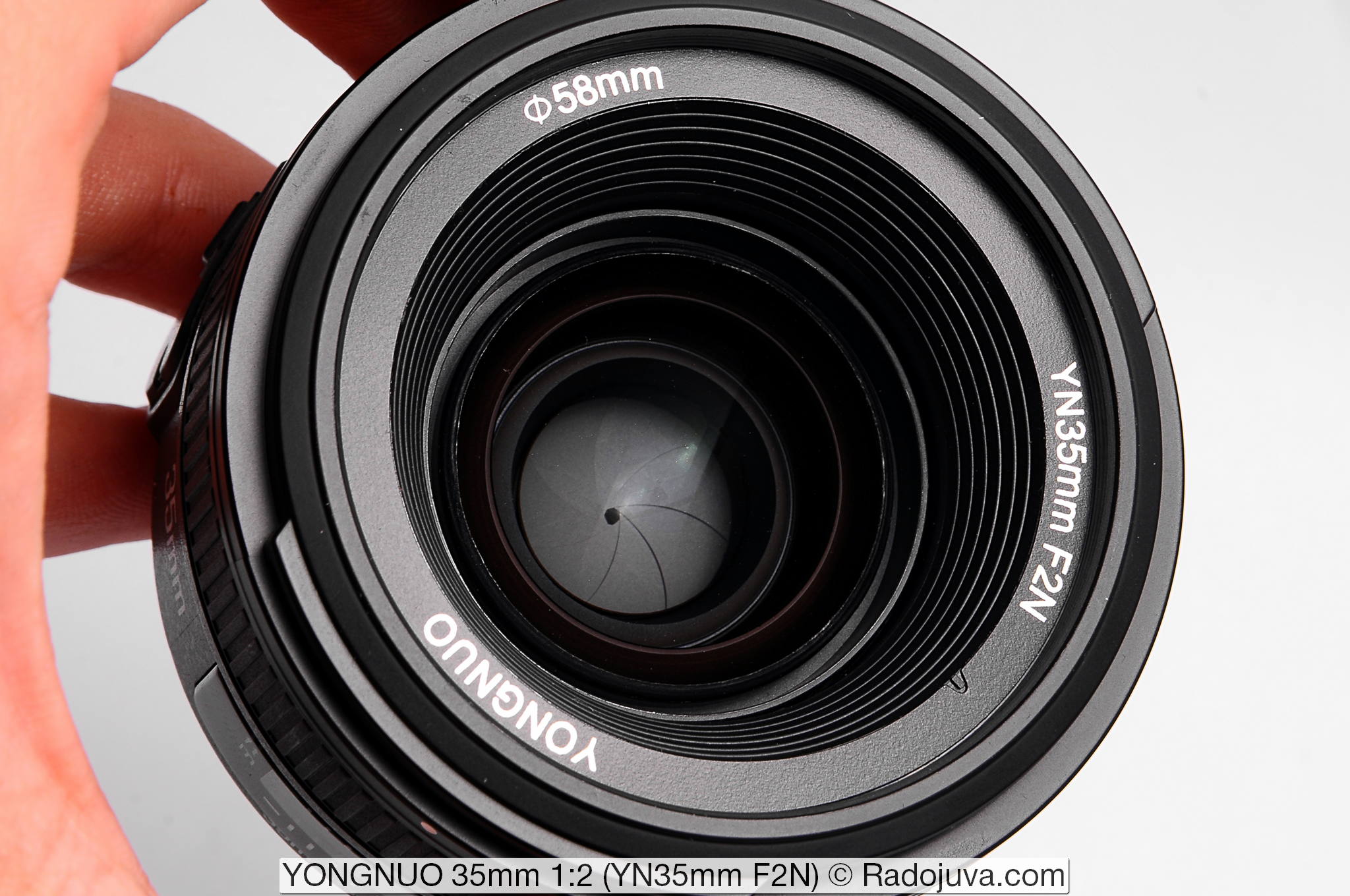
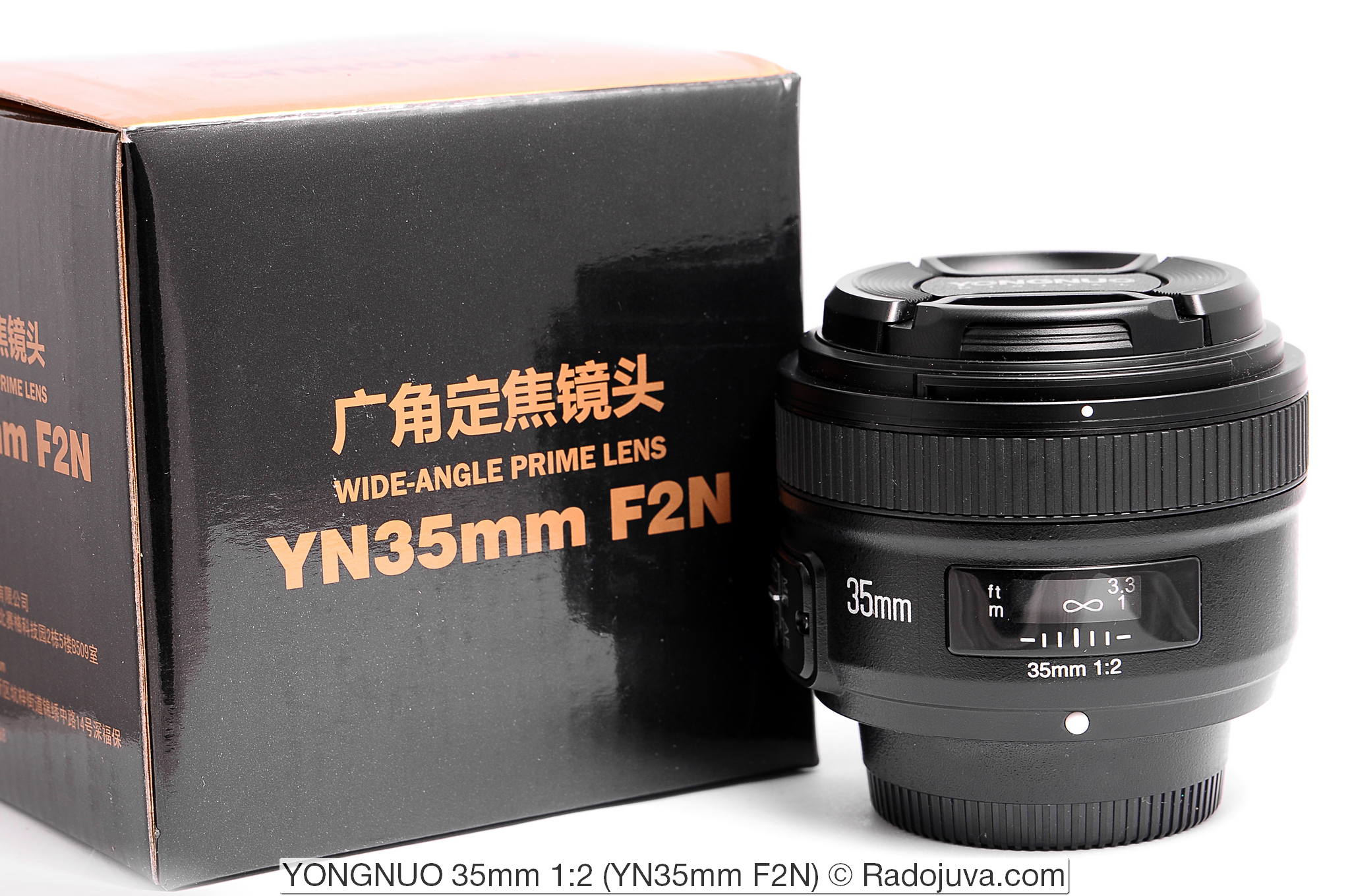
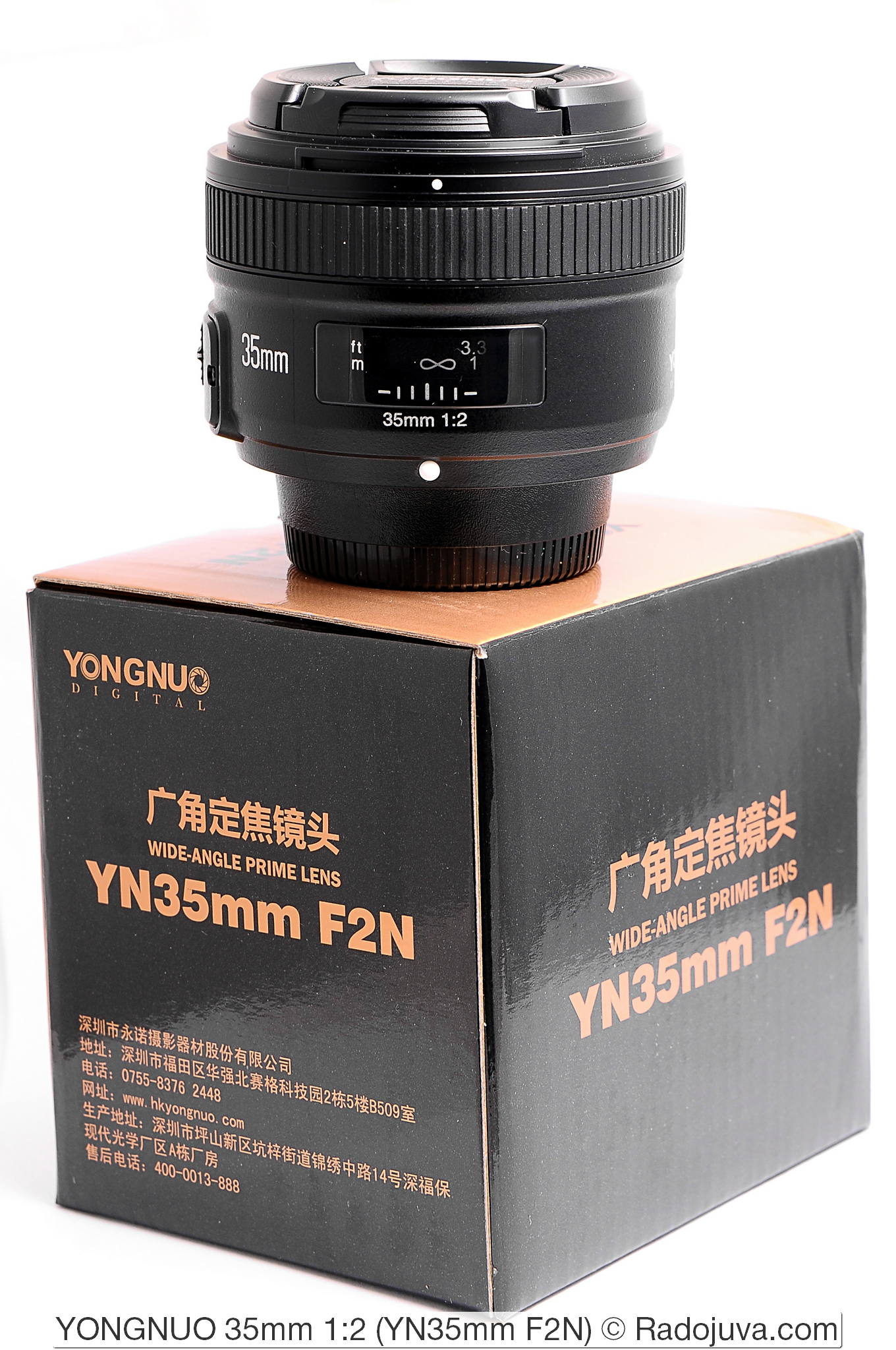
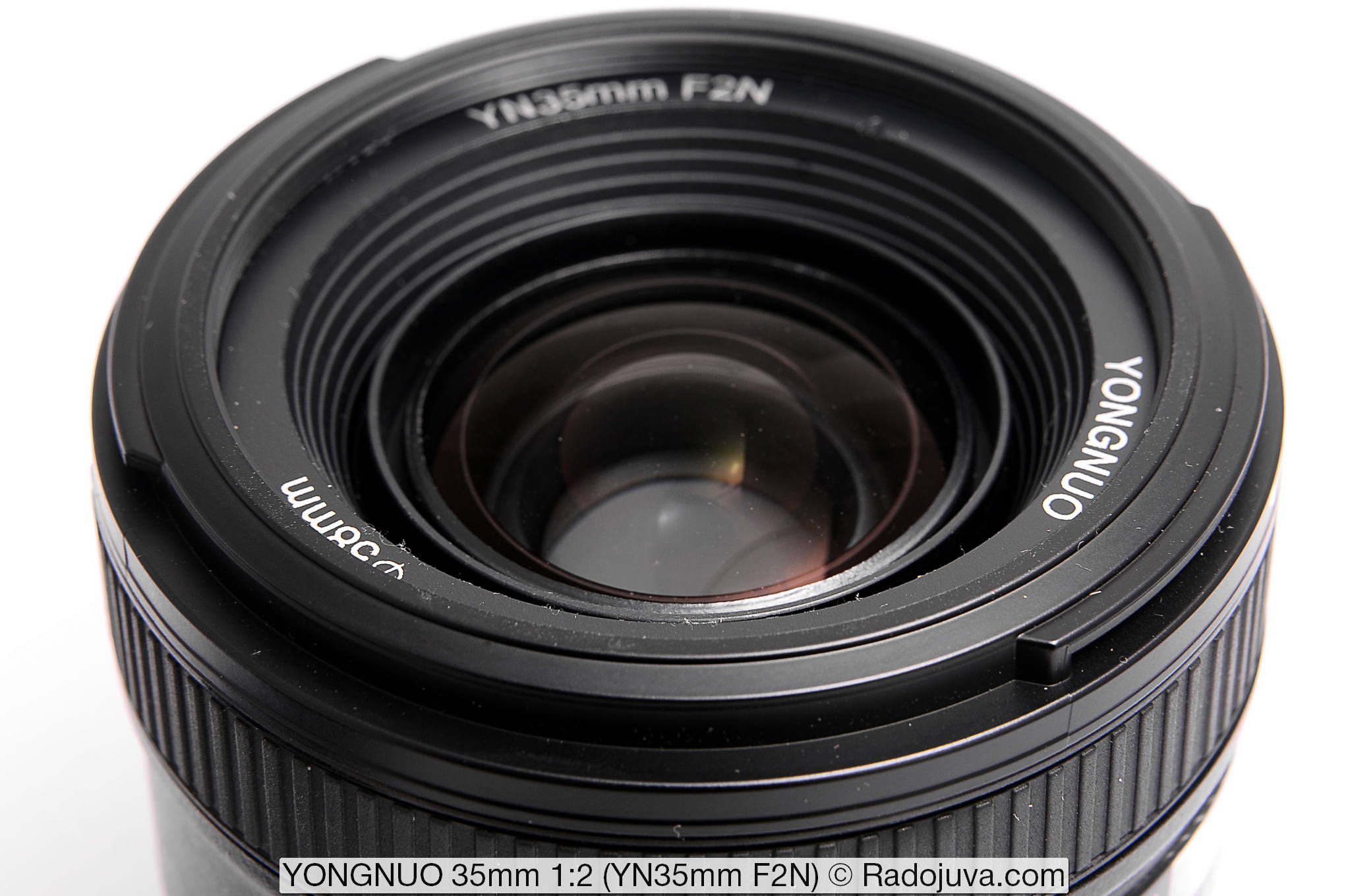

Arkady, please help me make a choice.
I am assembling a kit for the Nikon D600.
So far, from the lenses there is only the standard 24-85.
I choose a budget fix. Tell me, what will be more universal for this camera: 35mm 2: 0 or 50mm 1.8? You need to shoot both on the street and indoors, including people, subject matter and architecture. I want the aperture, which is missing in my zoom 24-85.
As I understand it, both focal lengths will be universal for the FF? Or am I mistaken?
And the items in the article were very confused:
“Perceptible vignetting on full-frame cameras and open apertures
drop in sharpness at the edges and corners of the frame on full-frame cameras ”
Is it worth it to abandon the idea of buying a fix from Yongnuo?
Thank you!
In the corners, only fairly expensive optics will adequately behave in the open.
35mm - more width, 50mm - more standard. The choice is always difficult. I have no obvious answer to your question. Try using your zoom to shoot a week at 35mm, and a week at 50mm, and then decide which focal point is preferable.
I got it. Thanks a lot!
Of course, Arkady is right. I will express my opinion. 35 2.0D is the freshest in my park, was bought with 20 and 50. I think 35 is the most successful lens. Comfortable to work in any conditions!
Hobby colleagues! Maybe someone has an electronic version of 4-hour video tutorials or a tutorial for the photographer, etc. If someone shares, thank you in advance! My email post office tuzoo@bk.ru
That feeling when I read your 50mm 1.8N review and ordered it at a run in China, but then accidentally found out from your 35mm review that the latter is better ... I in no way want to accuse you of anything, but it turns out strange, that everyone is so praising and longing for a 50mm fix, but in fact they advise a wide range of zoom or a 35mm fix :(
There are nuances. 50 mm for the crop is pleasant, but inconvenient as the only lens. 35mm is much more convenient.
Alexey, you yourself must decide what you need. In my humble opinion, 35mm is by no means a universal lens (in the sense of wearing it and nothing else is needed). The zoom still remains universal, especially when it comes to the street. Therefore, 35 or 50 are sensibly chosen anyway as additional prime lenses. And here everyone has their own tasks and preferences. For example, a high-aperture 35mm is more convenient in rooms and at events. But if you need a good background blur, soft drawing, close-up portrait, a bigger gain in aperture - for a crop of at least 50mm.
I am having autofocus problems on Nikon d3 with YONGNUO 35mm 1: 2 (YN35mm F2N). Almost does not "cling" to the target, and if it does catch on, then smoothly and for a very long time shifts the focus towards the MDF. Rearranged on d3100 - the problem of floating focus remains, but when the camera focus is set to focus priority mode, you can shoot before the focus “floats away” (In both cases, I shot in afs mode). setting focus priority to the nikon d3 with this lens resulted in it taking an unacceptably long focusing time.
In general, he did not fit on d3 (. I rent them on d3100 - I like the picture, the sharpness is arranged, but with autofocus there are small troubles.
Who cares, my copy turned into a manual, because on one of the coils the winding was torn. Who knows what about interchangeability? I would not want to rewind.
How many frames are approximately done?
Less than 1000 I think. I actively used summer (second) and a little winter (but this is not even the third in the list of frequency of use). I have been outside in freezing temperatures, in the rain - no. Dust and excess moisture also did not torment. Engine marking VT-10160 16-09-11 dual-anchor, Google does not know this.
Now I regret that I did not buy the Nikon Af-s Nikkor 16-85 mm f / 3.5-5.6G ED VR even three times more expensive and not for a full frame (which I still do not have).
Arkady, good afternoon
I understand correctly that the Yongnuo 3mm lens does not fit the Fujifilm FinePix S35 Pro camera
Does he behave incorrectly with this camera?
What would you recommend a full-time (single) lens to the Fujifilm FinePix S3 Pro?
The budget is limited (ideally up to $ 100. Invest, max $ 200)
For a long time it was decided where to start for itself FIXA or ZUMA.
It seems that I decided that I would start with a 35mm fix, and then there is such a "ASPH" in relation to the camera (((
Maybe I'm wrong and should I start with ZUMA with this camera?
Thanks for the answer))
Good day. It seems I haven’t written anywhere that he does not fit the S3 Pro. In all respects, the S3 Pro should work with this lens.
From cheap fixes around $ 100 - only Nikon 28 / 2.8D (MKI, II, III), Nikon 50 / 1.8D (MKI, MK II all sub-versions, MK III D), Yongnuo 35/2, Yongnuo 50 / 1.8. The standard crop is around 30 mm, with 50 mm it will be difficult.
Arkady, quote from a review
"Also the lens may behave strangely with some other cameras (example)."
Where the lens is wearing the Fujifilm FinePix S3 Pro
Until the end, I did not understand if Yongnuo 35/2 is unlimited, worry that I will make a choice on a lens that will not work adequately with the Fujifilm FinePix S3 Pro?
If you are worried, then use other native lenses that I indicated in a previous post. It may be worth saving up money and taking the native Nikon 35 / 1.8DX.
Arkady, I’m thinking a lot about this option about Nikon 35 / 1.8DX, when I accidentally saw in the review a link to incorrect operation of Yongnuo 35/2 with Fujifilm FinePix S3 Pro
True for me it is already a significant waste of money. I would like to make the right choice, and not make a mistake.
Last question: If you look at the picture quality with the Fujifilm FinePix S3 Pro, then what would be the only full-time lens you would take Nikon 35 / 1.8DX or Nikon 18-70mm (or another zoom up to 200 dollars)?
It's too difficult to live with one fix. For starters, I would still have gotten a zoom. Good budget options are Nikon 18-70, Nikon 18-135 (can be found generally cheap), Tamron 18-200 (first, screwdriver, or second - with a motor), Sigma 17-70 (first versions). For $ 200, you can find more serious lenses such as the Sigma 18-50 / 2.8 (I recommend it), Tamron 17-50 (the first versions).
I bought a used one for Avito, the focus is on the target and immediately tends to infinity, if you put the tracking one, then the picture is better, the picture is normal, with fifty dollars at d 50 and d 90 for family shooting, climbed on the walls, with this it is much more convenient! Considering that the Yangnow is 3 times cheaper than the Nikon 35 on the used market - an excellent device for home and leisurely photo experiments
Good day!
Arkady, please tell me if this lens is compatible with my Canon 650d?
I could not find a definite answer, but thanks to you, YN 35 mm became interested.
Thank you!
Good afternoon. This review shows the version for Nikon cameras. For Canon cameras, including Canon 650D, there is a similar lens - Yongnuo Lens EF 35mm 1: 2 (Model YN35mm F2). This information is in the section. All Yongnuo Digital Lenses / For Canon EOS Cameras.
I was flattered by the price, well, taking into account the transition to the full format, I bought it on Amazon, handed it over with an opportunity from the USA, flew by ... It was impossible to focus, it seemed to hit the target and immediately a gig-gig - the focus disappears. So there is a marriage in the USA ... It's good that a friend returns there, I give it back, the manufacturer's warranty is 1 year ...
Tell me which camera to let users know about possible incompatibilities. Thanks.
dilemma, what to take on the d600 - youngnau or used 2d? the first on alik for 5k +, the second on avito for 10k, as if the difference is not particularly significant, but is 2d more top-end ?! after all, they ask for a new one over 20k ...
It's simple. There is money - take Nikon 35 / 2D, there is no money or it is a pity - YN 35/2.
Yes, the fact of the matter is that since I took the FF, then I don’t save on glass) I just remembered that there is still 28mm 2,8d for 6k second-hand you can take)
It would be more correct - 35 / 1.8G, which is full-frame, very good glass.
There is already a completely different price tag
There is also a completely different quality. Cameras quickly become obsolete, glasses are much slower, but even so, 30 years is a very, very serious amount of time.
Personally, I absolutely did not like the 35mm f / 1.8G FX. I changed it twice, then passed it. Damn that for a lot of money.
For what reason did they change what they didn’t like?
I don’t remember everything. I remember well that the lens produced an abnormally high noise level in difficult conditions, at high ISO. Those. I knew for sure that such a terrible noise in such a lens should not be. And the noise was specific, black. The Shumodavs did not cope with him at all.
I am sure that under normal conditions, this lens is all right. But what for it is necessary in normal conditions, for so much money?
Peter, but the camera matrix is noisy, not the lens of the lens.
35 / 1.8G compared to 35 / 2D is much sharper on slightly covered diaphragms. Sharpness from 2.8 to 5.6 does not compare with 35 / 2D. With a 35 / 1.8G landscape, this would be useful, also for street shooting in low light conditions.
Mb in your camera or rav-converter slider sharpness / contrast were twisted much?
On ixbt recently there was testing 35 / 1.8G and 35 / 1.4G on the D850 and both of them turned out to be slightly different in their qualities. But they did not find critical flaws. What then to take under D850 from 35mm fixes? Tamron 35 / 1.8 with stub (also sharp say) or very sharp Sigma 35 / 1.4ART with oblique focus?
Mentioned:
With a 35 / 2D landscape, this would be useful, also for street shooting in low light conditions.
35 / 1.8G is certainly a little expensive, but the price of 28 / 1.8G is even higher.
Yes, and Canon 35/2 with a stub is also not cheap.
Tin, the lens makes noise at high ISO ... and, probably, there were broken pixels in it, yeah.
Not surprisingly, of the three pieces, not a single decent one (from Nikon!) Could not be selected for themselves.
Onotole, are you a professional photographer?
Pokemon, I assure you, with the sliders I'm fine)
The matrix is noisy from a lack of light.
So you took two similar lenses. They took pictures with them on the same camera, in the same conditions.
The picture clearly shows that with one lens there is more noise than with another.
What does this mean?
I'm not saying that the Nikon 35mm f / 1.8G FX is a bad lens. Personally, I did not like him. Perhaps he will suit you, who knows.
I took about 10-20 thousand frames with him, and he thoroughly disappointed me. I need it for reporting in extremely difficult conditions, in which amateurs do not shoot.
For myself, in a night city on shooting games I take Samyang 35mm f / 1.4.
This is just a great lens. If you can do without AF, you won’t find anything better for the money.
I don’t know about Sigma and Tamron, but I’m sure that they have everything in order with optics. It’s clear that they don’t take them for reporting, but for everything else I think they’re quite suitable.
Spherical horses in a vacuum from all testers should always be treated with caution. Their results show TX technology and nothing more. In real life, things can be very different.
By no means, I would say that it is rather the other way around, 100% amateur.
However, it is a big mistake to believe that only prof. photographers shoot with a lack of light.
If out of two lenses of the same class (for example 35 / 1.8), one gives a greater amount of noise in the image, then there are exactly 3 options:
1) this lens is in a specific way defective (like its two other copies) - nonsense;
2) this lens is in good working order, but constructively has aperture expressed in T-stops many times worse (at least 1,5-2 stops) than the other - also nonsense;
3) the user has not figured out the settings of the camera - the most likely and common occurrence.
Who says lovers don't shoot in a dim light? Have you carefully read my comment? And why did you suddenly decide that I don’t understand what I’m doing?
The noise level, as well as the type of noise, depends not only on the matrix and light, but equally on the lens. For example, in an old film-era lens, the noise will be different from a more modern digital lens.
Of course I read it carefully. You said that, and I quote: “abnormally high noise level in difficult conditions, at high ISO.” “I need him to report in extremely difficult conditions in which amateurs do not shoot.”
What is this if not an indication of an insufficient level of illumination, inaccessible to fans? Or do you raise the ISO for some other purpose than with a lack of light?
Have you carefully read my message? There I set out in detail why I believe that you “do not know what you are doing”, logical analysis based on a scientific approach, and then - the method of excluding extremely unlikely events.
If you think that I am mistaken - give your version of why this is happening, the mechanism of the appearance of these "noises", what exactly, in your opinion, is wrong with film lenses and, (most importantly!), Why no photographer before you did not notice.
Or just admit that they wrote nonsense, there is nothing so terrible about it.
Onotole, I can easily prove. But I will not, because I really do not like when I am rudely groundless.
All the best.
If a person believes that he is rude, while he (quite correctly and reasonably) indicated his mistake, then I don’t really want to communicate with such a person.
“Oh, that's it!…” Any girl can say, admit her mistake (or defend her point of view) - here a certain amount of courage is needed.
Still, digital noise is a phenomenon that occurs in the camera. Different lenses form a different image, but noise appears when digitizing and processing signals. Even if you saw differences in noise from two different lenses on completely identical parameters, there is no direct fault of the lens here. Nothing can be said about the quality of the lens by the noise level of the camera with it at high ISO. I have never met such a test or criterion. And the 35mm 1,8G FX is actually a very good lens, it’s a pity that you didn’t get it.
As an example, you should close the lens cover, turn on the maximum ISO, the shutter speed is longer and with different lenses we will get the same black rectangle with 99.99% similar noise :).
Most likely the “nature of the noise” referred to here is a mixture of the matrix noise with the lens pattern (bokeh, out-of-focus areas, discs of confusion, etc.). Subjective perception can sometimes still play a cruel joke and the visual perception of a picture from a lens with noise from a matrix does its job. But this is a very rare case.
Wow…
I have no words.
Boris, of course, noise is formed in the electronic filling of the camera. Who is arguing! But as you cannot understand, light delivers a lens to the matrix. How can he play no part? Do all lenses have a completely identical design and exactly the same lenses?
It's elementary!
So what, he loses a couple of stops along the way chtoli (compared to normal)?
Peter, what is elementary? Lens construction is different, images are different (low ISO, high ISO). Further, when the image is formed, the camera reads it and processes it - at this stage noise occurs. Once again: whether you see the differences in this noise in different lenses or not, this does not say anything about the quality of the lenses. It is your will to evaluate the lens this way and reject it, according to this criterion for your purpose, but because of this, it is simply not fair to write about it “what a hell of a lot of money” about it.
Arkady, yes this is a rare case. In addition, lenses with the same parameters and with different designs transmit light in different ways. As a result, a different amount of light can come into the matrix, and from different angles. This will be enough to make the matrix begin to make noise earlier, and at the same high ISO the picture will be worse. Here is what I am trying to explain.
Considering that on ZK all widths wider than 40 mm are retro-focus, the problems with incidence angles are minimal there. This is not a BZK, where you can find fault with color fishing and other joys because of the features of the matrix cells.
If the lenses have the same T-stops, then the amount of light is given the same, the light density may differ slightly from the edge to the center (vignette). But, also, I must state the fact that even if all these factors are present, it will be extremely difficult to achieve a spectacular and tangible increase in noise. Usually, nevertheless, those users who claim that “the lens gives excessive noise” are somehow mistaken somewhere. Here I also tend to think so, although I admit a certain other case.
What I specifically came across, and what I felt personally and what can be identified as “the lens is noisy” can relate to two things:
The first is that this or that camera specifically measures exposure. This is connected both with the scene being filmed and with the features of the camera / lens firmware. In such cases, some scenes may not be properly exposed, although visually it may appear that the exposure is normal. In such cases, there may indeed be an excess of noise, because the scene was incorrectly exposed. And if the content of the image is also such that it is easy to trace the noise, there is a false impression that the lens is making noise.
Second, with some scenes Nikon ADL works very hard, sometimes underexposing more than a stop. If an inexperienced user finds himself on a scene where the picture floated because of ADL (because ADL likes to underexpose and then “draw shadows”), then the same impression may appear. Especially if this was not the case with another lens. You can check about ADL yourself. With ADL disabled, all other things being equal, the camera can show the required shutter speed 2-2.5 times slower than with ADL. If we translate this into ISO terms, then in fact we get, for example, ISO 1600 instead of ISO 800.
But I want to note that this is a false impression and it depends on other factors, but not directly on the lens optics.
Arkady is right with ADL, incorrect exposure, and more. I myself had thought that the lens was noisy until I figured out what was the matter. Another noise reduction effect
Yes, I just turned on ADL all the time.
So I was wrong, the lens has nothing to do with it ...
Very good, I'll go buy it again.
It doesn't matter if they are right or wrong. It is important to become more experienced. I can also say from my practice - there are lenses that “do not fit” this or that photographer. This is also part of the psychological effects in our skulls, but this effect is very, very difficult to overcome. Therefore, if 35 / 1.8FX has not made friends with you, then there is no need to insist on friendship with him, at the same time, this should not mean that he is bad.
I really need this lens (Nikon 35me, f / 1.8 FX), I write without sarcasm. It’s just that 24-70 2.8 can’t cope, and 35Mm 1.8 must cope. I also use 85Mm 1.8 in such situations, instead of 70-200 2.8.
to play around and if you don’t feel sorry for the money, you can buy Yongnuo
Arkady, first of all I want to sincerely thank you for maintaining this blog, its usefulness cannot be overestimated - thank you very much human for your work!
Secondly, perhaps the following information will be useful to someone: I encountered a frequently occurring problem with the YN 35mm F / 2N in conjunction with the D5000 (there is no way to test with other cameras yet - all the familiar Canon photographers have it): a flashing green indicator of access to memory card with the camera turned off (Blinking green light of death (BGLOD)) and the battery will drain when this problem occurs. It was detected immediately after the first installation of the lens, before the first turn on the camera. To eliminate the blinking, you just need to turn the camera on and off again (often several times). The problem ALWAYS occurs if the camera is turned off while the focus mode is set to “MF” on the lens, much less often in “AF” mode. The problem ALWAYS occurs after removing and reinstalling the battery. This problem has never occurred with other lenses.
The seller on Ali contacted Yongnuo representatives, they don’t know such a problem, the seller offered to return the lens for replacement, but I’m not really eager, until I try with other cameras, I plan to switch from D5000 to D7100 in the future, besides, I'm a beginner amateur photographer, I don’t earn money by photographing and do not even plan yet, the problem doesn’t bother me much, but due to the nature of the character, her presence simply annoys me.
One of the readers of this blog, Konstantin, has the same problem - described in the comment dated 31.05.2018/5000/XNUMX in the subject of the Nikon DXNUMX camera review.
I would like to hear opinions on the possible causes of this problem, is there a possibility that it can be solved “once or twice” in the service? If someone has had such a problem with other Nikon models, please unsubscribe in the comments.
I do not yet know the solution to this problem.
This is a marriage, the lens must be definitely returned. Nobody will repair it later.
The other day I went to the workshop, tried it with the D5100 and two more nikons (I don’t remember the model, but one full-frame, the other crop). The problem with the flashing light is only with my D5000. Here is such a genetic incompatibility: /
In addition, an exchange was planned for the manual Nikkor 50mm f / 1.4, but it did not happen - a person needed 35mm autofocus to shoot video, but in conjunction with his D5100, the YN 35mm F2N autofocus speed for video shooting was unsatisfactory.
But there can be a problem with the memory card? If the card is low class.
Denis Grigoriev. I own a Nikon D5000 camera and a Yongnuo YN35mm F1: 2.0 N. lens. I do not observe the problems you described from the day you owned the lens. The camera was purchased at the peak of its release and recommendations for purchase. I don’t often take pictures, the camera often sometimes lies off for several days, without problems everything works when turned on and there is no indicator blinking. Perhaps these are compatibility issues.
Memory card - Kingston 8Gb (10) SDHC U1 (buggy, I can not format and delete photos from the computer, only on the camera everything can be done, it started after the camera was flashed, threw the firmware onto the memory card and rushed)
The battery is not the original 1800mAh (it is about 5 years old or higher, the original one is still alive, but I did not notice any problems there either)
Camera firmware version - А 1.01 B 1.00 L 1.001
Hah, Nikon has such an ambush :) A USB flash drive needs to make low-level formatting software for flash drive controllers. I just had the 3000th so locked.
I bought myself this glass. Half of the frames - the focus is generally past! The second half is the focus next to the DOF! When focusing (AF), you need to follow it and, if necessary, refocus again, but for this you must first aim much closer (or further) and then focus again. In general - the dances are still the same! The picture is mostly acceptable.
For a better understanding of the situation, it would be great if you would also indicate which camera you are using.
I wrote about the problem on July 27, Arkady asked which camera the problem was on, and the answer was Fuji S3 Pro, Nikon D200, D300. I apologize for being late, I was away. I sent the lens, I'm waiting for the result ...
Good evening.
I had the same problem on the D80 as the gentlemen above - autofocus worked through a stump-deck: it did not focus or after focusing it moved to the minimum distance.
I changed the lens in the store to another one of the same - it works fine.
I would advise you to carefully check on the spot when buying from hand and do not buy on the Internet.
Thanks for the review, he helped me decide to buy. My copy of the Yongnuo 35mm 1: 2 works with the Nikon D5100 as a cheap travel fix that is not a pity on vacation travel. Its work is unstable - the percentage of missed focus is about 10%, electronics failures were repeatedly observed, the camera had to be rebooted. My copy has light software for maximum sharpness and is similar in sharpness to the 18-105 whale. Kit 18-105 is much more stable in operation, but its dimensions interfere with the regular flash when it has to be used urgently.
On the D7100 with AF, a similar situation, 10-15% of the frames, the autofocus specifically smears (often even in the viewfinder it is clear that a specific miss), but I did not observe freezes, pah-pah, but, really, I still shot them a little. AF 18-105 and 18-140 - much more reliable
There are also problems with focusing, I’m using c D700, after the first shooting 30 percent went to the trash, now I’m used to it a little, I need to refocus 2-3 times, it’s visible in the viewfinder that it focuses a little closer once, the second time a little further, when I got closer
Suitable for unhurried shooting, not fast, a lot of marriage, still have to buy my native 35/2 since I really liked this focal
I got myself such glass because of its low weight and compactness. At first he annoyed me a lot with his uncertain focus. On D90, but having evaluated the results, I am ready to endure all his whims. Now I attached it to the D7000 and completely forgot about the problem, although he seems to have doubts about focusing. Or maybe I got used to it, I shoot a lot. Recommend. And besides, on the crop it is a full fifty dollars, which means there is no distortion. And yet it is not suitable for full-fledged reporting. But not all of them are engaged in reporting ...
Disappointed with the lens. On the d3000 it washes terribly, there is no sharpness even on manual focusing, autofocus is extremely rare. Compared with Helios 44m-4 - in terms of sharpness, just the earth and the sky. I already thought of using it as a manual one with such autofocus, but it is not good for anything either. The picture is also not very pleasant in color. The feeling of Chineseness remains from use ... In the picture, even with the aperture closed, distant small objects turn into a blur, as if instead of glass there is plastic. In general, in comparison with a whale, you can put the luminosity in plus, and everything else in minus. Now in thought, try to return it to the Chinese, try to sell it, or try to get a hand in order to get more or less acceptable results ...
This is not the first time the D3000 has planted a battery of 0 on the camera turned off! Who faced this?
Added information to the review. Most likely due to the curve of the lens firmware, which is constantly connected and disconnected from the camera. See if the access lamp for the memory card is blinking when it is turned off.
If you translate into MF mode, it blinks. I thought that only in this mode he plants the battery. But, unfortunately, AF has the same problem, although the indicator does not blink.
Do you think it's a bad idea to pull out the battery after every photo session? I don't see any other options ...
More or less used to the lens, in spite of the wildly smearing autofocus, it is quite suitable for its price.
You can still remove the lens from the camera. This is normal, as is removing a battery. True, it is a pity that the Chinese did not modify it.
Having added soob on d5300. For the wide range of health yn 35 mm is not a whistle. However, there is no problem, just do not look at the image at 100% zoom. The main problem is yn 35 mm on the d5300 autofocus robot. He lives his life, he often misses, although he wants to, if he doesn’t miss it, the back and the front will not show the trick.
Ale sell yogo not unsuccessfully, more plans for the d750. Having added d750 and having swayed a picture of the picture). The photos began to be reduced at the time (the number was less than the maximum on the d5300). Rіzkіst trokhi krasha nizh on nikkor 24-120 / 4 g. I myself smut normally zaprastuvav autofocus! Particularly accurate pratsuє autofocus with yongnuo 35 mm in group mode. Mauger such information to whom help with vibration)
Thank you, many come in handy.
And thank you very much for such a useful resource!
Thanks for the lens information! True, I first ordered both 50 and 35, and only then I saw your review. I’ve arrived 50 the other day, I didn’t have time to try too much, a few shots, and 35 on the way from China, I hope to come the other day. Thank you, I was convinced that I ordered it for good reason!
Professionals. Tell the lover. Yongnuo 35mm 1: 2 for Nikon D5100 suitable for shooting video? Thanks.
The lens is not bad for walking with a crop, but after several shots the autofocus stops working, it doesn’t cling and does not cling to the subject. Checked on 2 cameras. I would not recommend it for purchase, since I know that such a malfunction with novia is not only with me.
The same, only on YONGNUO 40mm 1: 2.8.
I read reviews about poor focusing, took the D90 and went to the store to "try" it. Brought out a zero lens in all bags and films. The reviews were confirmed. At a focusing distance of 1-2 meters, it is still somehow bearable, every other time exactly or by. At focusing distances over 3-4 meters - a stable huge back focus. LiveView has no hits. Is this normal? This is the first time I see this, so that even the contrast is wrong. In the same store I tried the original 35ku - everything is fine, chromatite, however, like damn :)
And what was the chromat version 35?
The one that dx / 1.8g or for fx / 1.8g?
Here is the second for fx, chromatite is very unpleasant - it seems tougher than Nikkor 35 / 1.4, than Sigma 35 / 1.4 Art and Tamron 35 / 1.8.
35 1.8 G DX, even at 2.8 HA significant. No more closing. The store is clearly visible, many light sources, many reflective surfaces.